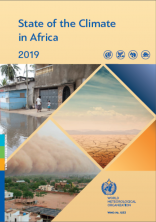State of the Climate in Africa

Temperatures in Africa have been rising in recent decades at a rate comparable to that of most other continents and thus somewhat faster than global mean surface temperature, which incorporates a large ocean component. The year 2019 was among the three warmest years on record for the continent.
Annual rainfall exhibited sharp geographical contrasts in 2019, with totals remarkably below long-term means in Southern Africa and west of the High Atlas Mountains and above-average rainfall recorded in other areas, in particular in Central and East Africa.
There is significant regional variability in sea-level trends around Africa. Sea-level increase reached 5 mm per year in several oceanic areas surrounding the continent and exceeded 5 mm per year in the south-western Indian Ocean from Madagascar eastward towards and beyond Mauritius. This is more than the average global sea-level rise of 3–4 mm per year.
Africa was severely hit by extreme weather and climate events in 2019, including Tropical Cyclone Idai, which was among the most destructive
tropical cyclones ever recorded in the southern hemisphere. Tropical Cyclones Idai and Kenneth resulted in severe humanitarian impacts, including hundreds of casualties and hundreds of thousands of displaced persons.
The areas most severely affected by drought in 2019 were in Southern Africa and were many of the same areas that were also affected by a protracted drought in 2014–2016. In contrast, a dramatic shift in conditions was experienced in the Greater Horn of Africa, from very dry conditions in 2018 and most of 2019 to floods and landslides associated with heavy rainfall in late 2019. Flooding also affected the Sahel and surrounding areas from May to October 2019.